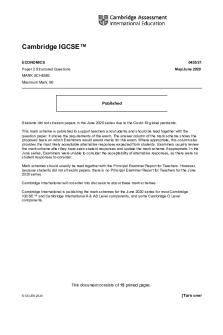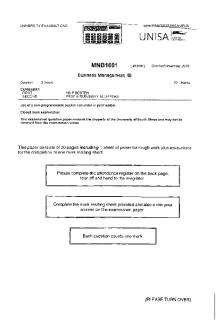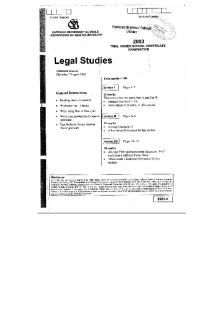0452 s20 ms 22 - Past exam paper gives an understanding of how to attempt the board exams. PDF

| Title | 0452 s20 ms 22 - Past exam paper gives an understanding of how to attempt the board exams. |
|---|---|
| Course | Accounting |
| Institution | University of Wollongong in Dubai |
| Pages | 12 |
| File Size | 330.4 KB |
| File Type | |
| Total Downloads | 77 |
| Total Views | 135 |
Summary
Past exam paper gives an understanding of how to attempt the board exams....
Description
Cambridge IGCSE™ ACCOUNTING
0452/22
Paper 2
May/June 2020
MARK SCHEME Maximum Mark: 120
Published
Students did not sit exam papers in the June 2020 series due to the Covid-19 global pandemic. This mark scheme is published to support teachers and students and should be read together with the question paper. It shows the requirements of the exam. The answer column of the mark scheme shows the proposed basis on which Examiners would award marks for this exam. Where appropriate, this column also provides the most likely acceptable alternative responses expected from students. Examiners usually review the mark scheme after they have seen student responses and update the mark scheme if appropriate. In the June series, Examiners were unable to consider the acceptability of alternative responses, as there were no student responses to consider. Mark schemes should usually be read together with the Principal Examiner Report for Teachers. However, because students did not sit exam papers, there is no Principal Examiner Report for Teachers for the June 2020 series. Cambridge International will not enter into discussions about these mark schemes. Cambridge International is publishing the mark schemes for the June 2020 series for most Cambridge IGCSE™ and Cambridge International A & AS Level components, and some Cambridge O Level components.
This document consists of 12 printed pages. © UCLES 2020
[Turn over
0452/22
Cambridge IGCSE – Mark Scheme PUBLISHED Generic Marking Principles
May/June 2020
These general marking principles must be applied by all examiners when marking candidate answers. They should be applied alongside the specific content of the mark scheme or generic level descriptors for a question. Each question paper and mark scheme will also comply with these marking principles. GENERIC MARKING PRINCIPLE 1: Marks must be awarded in line with: • • •
the specific content of the mark scheme or the generic level descriptors for the question the specific skills defined in the mark scheme or in the generic level descriptors for the question the standard of response required by a candidate as exemplified by the standardisation scripts.
GENERIC MARKING PRINCIPLE 2: Marks awarded are always whole marks (not half marks, or other fractions). GENERIC MARKING PRINCIPLE 3: Marks must be awarded positively: • • • • •
marks are awarded for correct/valid answers, as defined in the mark scheme. However, credit is given for valid answers which go beyond the scope of the syllabus and mark scheme, referring to your Team Leader as appropriate marks are awarded when candidates clearly demonstrate what they know and can do marks are not deducted for errors marks are not deducted for omissions answers should only be judged on the quality of spelling, punctuation and grammar when these features are specifically assessed by the question as indicated by the mark scheme. The meaning, however, should be unambiguous.
GENERIC MARKING PRINCIPLE 4: Rules must be applied consistently e.g. in situations where candidates have not followed instructions or in the application of generic level descriptors.
© UCLES 2020
Page 2 of 12
0452/22
Cambridge IGCSE – Mark Scheme PUBLISHED
May/June 2020
GENERIC MARKING PRINCIPLE 5: Marks should be awarded using the full range of marks defined in the mark scheme for the question (however; the use of the full mark range may be limited according to the quality of the candidate responses seen). GENERIC MARKING PRINCIPLE 6: Marks awarded are based solely on the requirements as defined in the mark scheme. Marks should not be awarded with grade thresholds or grade descriptors in mind.
© UCLES 2020
Page 3 of 12
0452/22
Cambridge IGCSE – Mark Scheme PUBLISHED
Question
Answer
1(a)
Bilal Purchases journal Date 2020 April 4 5 13 30
Marks 4
Details
$
Milly (320 – 64) EHL Limited Todd Transfer to purchases account
1(b)
256 500 250 1 006
(1) (1) (1) (1)OF
Bilal Cash Book Disc. Alld $ 2020 Apr 1 8 12 28
Balance b/d Sales Sales Disposal
Cash
Bank
$
$
160 (1) (1) (1)
110 50
320 2020 May 1
Balance b/d
192 (1)OF
2020 1 960 Apr 6 280 10 17 21 24 30 2 240 870 (1)OF
Dates (1)
© UCLES 2020
May/June 2020
Page 4 of 12
12 Disc. Recd $ Stationery Milly Office equip. Todd EHL Limited Balance c/d
(1) (1) (1) (1) (1)
Cash
Bank
$
$ 145
128 10 15 25(1)
192 320
500 240 485 870 2 240
0452/22
Cambridge IGCSE – Mark Scheme PUBLISHED
Question
May/June 2020
Answer
Marks
1(c)
accounting principle The double entry for the posting of the purchases journal entries is completed by posting the individual amounts to the purchases ledger.
duality (1)
The purchase of goods on 5 April did not include goods costing $55 which Bilal bought for his own use.
business entity (1)
The stationery purchased on 6 April had been recycled. This is expected to improve the reputation of the business. Reputation is not recorded in the accounting statements.
money measurement (1)
The value of office equipment shown in the financial statements was based on its purchase price.
historic cost (1)
Question
Answer
2(a)
Marks $ 845 (1) 1 570 130 615 11 200 14 360 (1) 250 140
Subscriptions in arrears Cash at bank Cash in hand Inventory Fixtures and fittings Subscriptions in advance Wages outstanding Accumulated fund
4
$
4
390 (1) 13 970 (1)(OF)
2(b)
The accumulated fund is built up from the annual surpluses (1) less any annual deficits (1) Accept other valid points
2
2(c)
1250 + 115 – 140 (1) = 1225 (1)OF
2
© UCLES 2020
Page 5 of 12
0452/22
Cambridge IGCSE – Mark Scheme PUBLISHED
Question
Answer
2(d)
K Music Club Subscriptions account 2019 Apr 1 2020 Mar 31
Balance b/d Income and Expenditure Balance c/d
$ 845 (1)
2019 Apr 1 2020 8 820 (1)OF Mar 31 215
Marks
Balance b/d Bank Irrecoverable debts Balance c/d
9 880 2020 Apl 1 2(e)
Balance b/d
975 (1)OF
2020 Apl 1
Balance b/d
7 $ 250 (1) 8 500 (1) 155 (1) 975 9 880 215 (1)OF
Advantages Subscriptions in arrears have risen from $845 to $975, so this may be a concern (1) Subscriptions in arrears are significantly higher than subscriptions in advance (1) Irrecoverable debts would be minimised particularly if the direct debits were set up for the start of the year (1) The timing of cash receipts from members will be known (1) Administration costs may be reduced (1) Accept other valid points Max (2) Disadvantages Members may prefer to choose their own method of payment (1) They may prefer to pay their subscription at a time of their choosing (1) Some members may decide not to renew their membership (1) Accept other valid points Max (2) Recommendation (1)
© UCLES 2020
May/June 2020
Page 6 of 12
5
0452/22
Cambridge IGCSE – Mark Scheme PUBLISHED
May/June 2020
Question
Answer
3(a)
Gok Income Statement for the year ended 29 February 2020 $ Revenue Less Sales returns Cost of sales Opening inventory Purchases
420 000 12 000
Less Expenses Discount allowed Wages Rent and rates General expenses Irrecoverable debts Insurance (4 500 – 1 500) Telephone expenses (4 565(1) + [1 660/4] (1)) Depreciation on Fixtures and equipment (20% × 76 800) (1) Profit from operations Loan interest (60 000 × 7%)(1) × 8/12(1) Profit for the year
Page 7 of 12
9 000 12 360 11 750 4 220 8 600 3 000 4 980 15 360
15 $ 408 000 (1)
26 700 311 400 338 100 32 100 (1)OF
Less Closing inventory Gross profit
© UCLES 2020
Marks
306 000 (1) OF 102 000 (1)
(1) } }(1) } (1) (1) (1)OF
69 270 32 730 2 800 29 930 (1)OF
0452/22
Cambridge IGCSE – Mark Scheme PUBLISHED
May/June 2020
Question
Answer
Marks
3(b)
Advantages Gok would no longer need to pay wages to Aiman as he would not be an employee (1) Aiman may invest capital into the business (1) Gok would consider how much capital would be introduced by Aiman (1) The risks and responsibilities would be shared with Aiman (1) Aiman may have skills which could be used in the business, other than those which he currently uses as a warehouse assistant (1) Aiman may be prepared to work longer hours in the business if he became a partner (1) Currently Gok has not had time to carry out an inventory count so it seems that any extra hours which Aiman may work would be helpful (1) Accept other valid points Max (2)
5
Disadvantages Gok would no longer be able to take all the decisions on his own (1) Aiman would be entitled to a share of the profits (1) Gok would consider how profits and losses are to be shared (1) Aiman would expect to take drawings from the business (1) Accept other valid points Max (2) Recommendation (1)
Question
Answer
4(a) 2020 Mar 31
Purchases Commission payable Commission receivable
4(b)(i) © UCLES 2020
Nadia Suspense account $ 2020 110 (1) Mar 31 Difference on trial balance 65 (1) Discount allowed Insurance 65 (1) Drawings 240
Error of principle (1)
Marks 7 $ 24 28 18 170 240
(1)OF (1) (1) (1) 1
Page 8 of 12
0452/22
Cambridge IGCSE – Mark Scheme PUBLISHED
Question 4(b)(ii)
May/June 2020
Answer
Marks
Error of commission (1)
1
4(c)
7 Nadia Statement of corrected profit for the year ended 31 March 2020 $ 6720
Profit for the year before corrections No effect Error 1 Error 2 Error 3 Error 4 Error 5 Error 6 Error 7 Corrected profit for the year
Decrease in profit $ 28 (1) 18 (1)
130 (1) nil (1) nil (1)
4(d)
190 (1) ___ 236
___ 240
4(1)(OF) 6724
Nadia Journal Date 2020 March 31 March 31
© UCLES 2020
Increase in profit $ 110
4 Debit $
Details
Irrecoverable debts DD Supplies
300 (1)
Income statement Provision for doubtful debts
284 (1)
Credit $
300 (1)
Page 9 of 12
284 (1)
0452/22
Cambridge IGCSE – Mark Scheme PUBLISHED
Question 5(a)
Answer Rate of inventory turnover (8 000 + 121618 − 11050) (1) 118 568 = = 12.45 times (1)OF (8 000 + 11050 / 2 (1) 9 525
May/June 2020 Marks 5
Trade receivables turnover 28 700 365 × (1) whole formula = 50 days (1)OF 209 510 1
5(b)(i)
Risk of obsolete inventory (1) Risk of damage to inventory (1) Increased storage costs (1) May need to reduce selling price to sell old inventory (1) Cash is tied up longer in inventory (1) May mean missed business opportunities if insufficient cash (1) Accept other valid points Max (3)
3
5(b)(ii)
Risk of irrecoverable debts (1) A provision for doubtful debts may be required (1) Credit control may need to be reviewed (1) Cash tied up in trade receivables (1) May mean missed business opportunities if insufficient cash (1) Effect may be significant as all sales are on credit (1) Accept other valid points Max (3)
3
© UCLES 2020
Page 10 of 12
0452/22
Cambridge IGCSE – Mark Scheme PUBLISHED
Question 5(c)
Answer Cash discount Advantages Cash will be received significantly earlier (1) Good customer relationships are maintained (1) Credit control costs may be reduced (1) Irrecoverable debts may be reduced (1) Accept other valid points Max (1) Disadvantages Less cash will be received (1) 1% may not be enough to encourage earlier payment (1) If customers have insufficient funds to pay the cash discount may have no effect (1) Accept other valid points Max (1) Interest Advantages
More cash may be received (1) Cash may be received earlier (1) Interest received will increase profit (1) Irrecoverable debts may be reduced (1) Accept other valid points Max (1) Disadvantages Customer relationships may worsen (1) Increased administration costs (1) Customers may refuse to pay the interest (1) Customers may find an alternative supplier (1) Accept other valid points Max (1) Recommendation (1)
© UCLES 2020
Page 11 of 12
May/June 2020 Marks 5
0452/22 Question
Cambridge IGCSE – Mark Scheme PUBLISHED Answer
May/June 2020 Marks
5(d)(i)
Accounting policies should be applied consistently so that financial statements can be compared from year to year (1) Financial statements can be compared with similar businesses (1) Any change in the company’s accounting policies, and the effect of the change, should be disclosed (1) Accept other valid points Max (2)
2
5(d)(ii)
Information is relevant if it is capable of influencing the decisions being made (1) Information must be available in time for decisions to be taken (1) Relevant information helps the directors to evaluate past, present and future events (1) Accept other valid points Max (2)
2
© UCLES 2020
Page 12 of 12...
Similar Free PDFs

9701 s20 ms 22 - imp
- 12 Pages

0455 s20 ms 21 - past papers
- 15 Pages

0455 s20 ms 11 - past papers
- 3 Pages

STAT270 - past exam paper
- 24 Pages

Past exam Paper 2018
- 23 Pages

Board of Directors Paper
- 8 Pages

Trial past exam paper
- 7 Pages

MA103 Past Paper Exam
- 5 Pages

2010 exam - past paper
- 25 Pages

Past Exams at the ANU
- 4 Pages
Popular Institutions
- Tinajero National High School - Annex
- Politeknik Caltex Riau
- Yokohama City University
- SGT University
- University of Al-Qadisiyah
- Divine Word College of Vigan
- Techniek College Rotterdam
- Universidade de Santiago
- Universiti Teknologi MARA Cawangan Johor Kampus Pasir Gudang
- Poltekkes Kemenkes Yogyakarta
- Baguio City National High School
- Colegio san marcos
- preparatoria uno
- Centro de Bachillerato Tecnológico Industrial y de Servicios No. 107
- Dalian Maritime University
- Quang Trung Secondary School
- Colegio Tecnológico en Informática
- Corporación Regional de Educación Superior
- Grupo CEDVA
- Dar Al Uloom University
- Centro de Estudios Preuniversitarios de la Universidad Nacional de Ingeniería
- 上智大学
- Aakash International School, Nuna Majara
- San Felipe Neri Catholic School
- Kang Chiao International School - New Taipei City
- Misamis Occidental National High School
- Institución Educativa Escuela Normal Juan Ladrilleros
- Kolehiyo ng Pantukan
- Batanes State College
- Instituto Continental
- Sekolah Menengah Kejuruan Kesehatan Kaltara (Tarakan)
- Colegio de La Inmaculada Concepcion - Cebu





